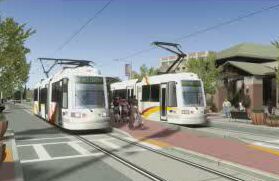|
Electrification 101
Ready-to-Go Urban Rail Projects
as a Medium-Term Response to America's Oil Problems
Commentary by Alan S. Drake
May 2007
NOTE: This is the fourth commentary in our series Electrification 101 – a discussion aimed at informing transportation professionals, decisionmakers, and the public at large of the value and advantages of electrifying transportation operations, and the electrification of public transport systems in particular.
Alan S. Drake, a former accountant, is an engineer and professional researcher based in New Orleans.
Among his specializations are public transportation and energy issues.
The United States of America is addicted to oil.
And oil prices keep climbing, plus future availability is a very serious concern.
What if Iran is bombed, Saudi Arabia has a revolution?
What about Chavez in Venezuela, Nigerian and Iraqi civil wars, more hurricanes, or any other major oil supply interruption?
And what if world oil production peaks and starts declining?
World oil exports will shrink even faster than world oil production.
Half the world's oil production is used in the nation of production; the balance is exported.
In a shrinking – or even flat – oil production world, domestic demand will still grow
in many oil exporting nations, shrinking the volume of available exports.
A serious and prolonged crunch is in store for the United States if world oil production just fails to increase steadily.
What can be done, and preferably done quickly, to save significant amounts of gasoline and provide a non-oil alternative for many millions of American commuters?
A non-oil transportation alternative would be especially useful during a
prolonged oil supply interruption or shortfall, when the Strategic Petroleum Reserve will simply not be enough.
One very viable alternative is to build much more urban rail – in particular, electrified urban rail – and build it quickly.
Such an approach also can preserve the quality of urban functioning while ensuring adequate mobility.
In the USA, efforts to develop an adequate safety net of urban rail has been starved for funding at the federal level for decades – and even more so in recent years.
One way the Federal Transit Administration rations out the relatively few dollars available is by slowing down all projects as much as possible.
Thus it takes decades to build out new urban rail systems, one slow project after another.
The French, with a much smaller population but much greater determination to be more energy self-reliant, are building as much new
urban rail as the United States – and all running on electricity.
Amazingly, it takes as little as three or four years from a Oui in Paris to a ribbon-cutting.
In contrast, the infamous American bureaucracy drags projects out for unnecessary years.
(A can-do, just-solve-the-problem French attitude vs. a stodgy, red-tape-focused American policy: is there something wrong with this picture?)
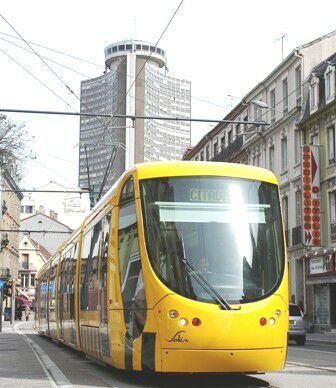 France has been vigorously installing new urban electric rail systems, such as this tramway system opened in 2006 in the small French town of Mulhouse (pop. 111,300).
France has been vigorously installing new urban electric rail systems, such as this tramway system opened in 2006 in the small French town of Mulhouse (pop. 111,300).
[Photo: SITRAM]
I have developed a list of urban rail projects in the United States that are close to "ready-to-go".
In most cases, specific routes have been determined, some engineering
has been done, and, for some projects, an Environmental impact Statement (EIS) has been prepared (although this may need updating).
"If 90% federal funding (the same percentage of federal funding that built the interstate Highway
system) were available, all of the projects listed below could, and likely would, break ground within 12 to 36 months.
Completion dates would vary, depending upon the project, but a significant fraction of US oil consumption could be diverted to very high mileage electrified rail within a decade (see http://strickland.ca/efficiency.html).
And many Americans will have a non-oil alternative to get to work.
Reducing total US oil consumption by 4% (transportation oil use by 6%) is a
reasonable goal in a dozen years just by focusing on building urban rail.
These oil savings are comparable to an optimistic estimate of Arctic National Wildlife Refuge (ANWR) oil production – but
unlike oil production, these savings will grow, and not deplete.
Of course, other urban rail projects should be developed as this first phase is under
construction, and coordinated with other oil-saving initiatives.
An urban rail development program on this scale would, of course, create a vast building boom with spot shortages of critical resources.
However, anticipation of continued demand should bring new supplies and suppliers into the market without undue delays or cost increases.
Greater volumes in vehicles, rail, transformers and other items should bring efficiencies of scale and lower costs.
Standardized engineering plans (such as exist for roads) could also bring best practices at lower costs.
Urban rail projects that could be included in a Phase One program are listed below.
These include electric light rail transit systems, commuter rail [regional passenger rail], systems, and subway-elevated or metro systems.
A rough "horseback" estimate is that these projects would cost approximately $135 to $175 billion to complete.
[NOTE: in the following listing, Alan Drake has preferred to identify regional passenger rail (RPR) systems (which use "heavy" railroad infrastructure and rolling stock for urban-focused suburban and regional services) with the commonly used designation "commuter rail".
The Light Rail Now Project follows a growing trend in using the "regional rail" or RPR designation of this mode, since this term more accurately emphasizes
the versatility of RPR in providing all-day services for a variety of trip purposes, and not just peak work commuter trips.
However, Light Rail Now has deferred to Alan Drake's preference for using the "commuter rail" term in his commentary.
Alan felt that "commuter rail" is a "known, positive description" while the RPR term might lead to confusion with intercity rail service such as Amtrak.]
Albuquerque
Plans for new light rail streetcar system; commuter rail expansion under way (see Albuquerque public transport developments)
Ames (iowa)
Proposal for new light rail streetcar system
Atlanta
Beltway light rail, northern suburbs light rail extension, central-city Peachtree streetcar; plans for new
commuter rail service
Austin
Two light rail lines plus commuter rail and central-city streetcar lines (see Austin public transport developments)
Baltimore
East-west light rail line, 4-mile extension to current subway (see Baltimore public transport developments)
Baton Rouge
Proposed light rail streetcar system
Bayonne (New Jersey)
Proposed light rail streetcar system (see New Jersey public transport developments)
Birmingham (Alabama)
Light rail streetcar lines (see Birmingham public transport developments)
Boise (idaho)
Proposed light rail streetcar system
Boston
North Station-South Station link, rail plans promised as environmental offset to "Big Dig", restoration of
Arborway light rail line, replacement of Silver Line "BRT" project with light rail (see Boston public transport developments)
Bradenton (Florida)
Proposed light rail system
Buffalo
Planned extensions to current light rail subway-surface line (see Buffalo public transport developments)
Charleston (SC)
Light rail streetcar system proposed
Charleston (WV)
Interurban light rail line to Huntington proposed
Charlotte
All plans (interurban and streetcar light rail, commuter rail) currently scheduled (see Charlotte public transport developments)
Charlottesville (Virginia)
Light rail streetcar system proposed
Chicago
Expansions to Metra, South Shore Line
Cincinnati
Light rail plans (previously voted down) and streetcar plans, possibly using abandoned rapid transit tunnel (see Cincinnati public transport developments)
Columbus
Light rail interurban and streetcar lines (see Columbus public transport developments)
Corpus Christi
Light rail streetcar line
Dallas
All plans through 2015 and all 2015-2030 options (roughly 145-mile system) (see Dallas public transport developments)
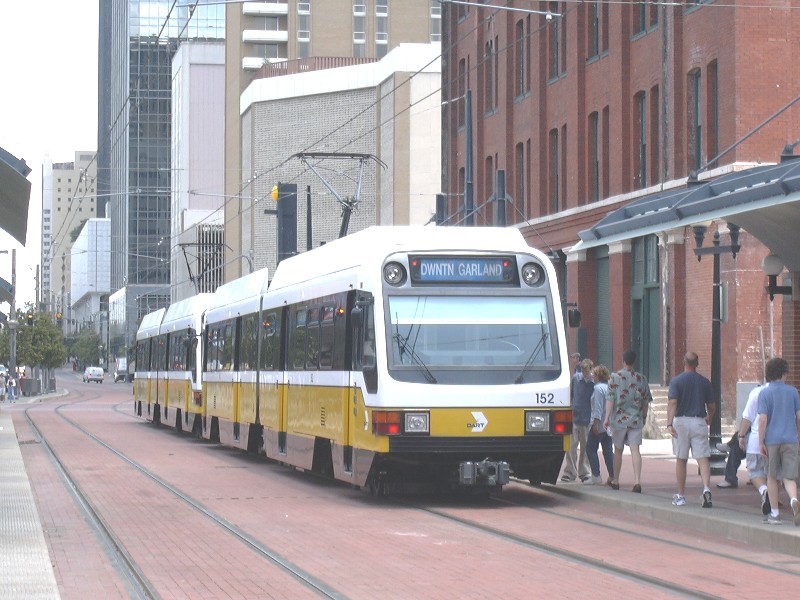 Dallas Area Rapid Transit's electric light rail transit system has proven tremendously effective in attracting new ridership and helping to revitalize both the regional transit system and the city's central business district.
Strong local and regional support for rail has fueled a vigorous expansion program of both LRT and the commuter rail system.
Dallas Area Rapid Transit's electric light rail transit system has proven tremendously effective in attracting new ridership and helping to revitalize both the regional transit system and the city's central business district.
Strong local and regional support for rail has fueled a vigorous expansion program of both LRT and the commuter rail system.
[Photo: L. Henry]
Dayton
Light rail streetcar plans
Denver
117 miles of light rail and commuter rail (already locally funded) (see Denver public transport developments)
Des Moines
Light rail (interurban or streetcar) system proposed
Detroit
Proposals for urban light rail, commuter rail link to Ann Arbor
El Paso
Downtown-to-border light rail
Fayetteville (Arkansas)
Proposed interurban light railway or commuter rail
Ft. Collins
Upgrading and expansion of streetcar operation into urban system
Ft. Lauderdale
Light rail semi-metro and streetcar plans under active development
Ft. Worth
Proposed light rail streetcar system, expansion of commuter rail
Harrisburg
commuter rail system
Honolulu
Light rail (or light rapid transit) line currently under development (see Honolulu public transport developments)
Houston
All plans voted for, including 65 new miles light rail, 8 miles commuter rail (see Houston public transport developments)
Hudson-Bergen (New Jersey)
Expansion of light rail system (see New Jersey public transport developments)
Huntington (WV)
Proposed light rail streetcar system
Indianapolis
Light rail system plans
Kansas City
Light rail line proposed (see Kansas City public transport developments)
Knoxville
Proposed light rail streetcar system
Lancaster (Pennsylvania)
Light rail streetcar system proposed
Lansing
Proposals for light rail or regional rail system
Las Vegas
Light rail plans (see Las Vegas public transport developments)
Lehigh Valley (Pennsylvania)
Proposed interurban light rail or commuter rail
Little Rock
Short extensions of existing streetcar line, light rail line (see Little Rock public transport developments)
Lorain (Ohio)
Proposed light rail streetcar system
Los Angeles
Rail rapid transit (Red Line extension) "Subway to the Sea", Vermont Avenue subway, additional miles of
light rail, urban streetcar system, electric trolley bus plan, electrification of commuter rail (see Los Angeles public transport developments)
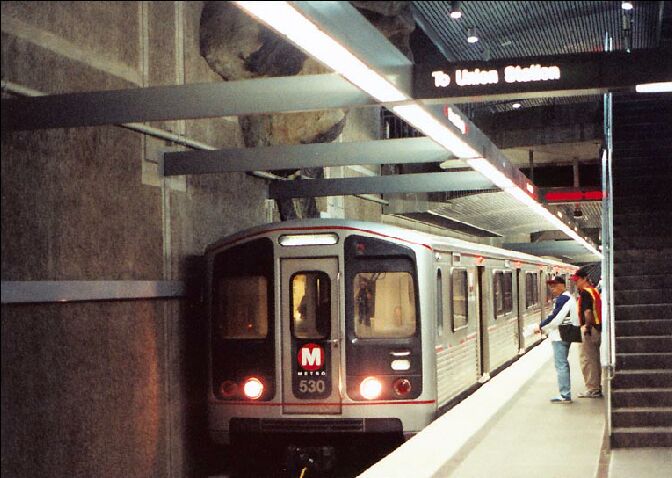 Tremendous success of Los Angeles's rail systems has fed local enthusiasm for expansion.
Proposals are being pushed forward to extend the metro system further along Wilshire Blvd. to Santa Monica on the Pacific Ocean – the long-awaited "Subway to the Sea".
Tremendous success of Los Angeles's rail systems has fed local enthusiasm for expansion.
Proposals are being pushed forward to extend the metro system further along Wilshire Blvd. to Santa Monica on the Pacific Ocean – the long-awaited "Subway to the Sea".
[Photo: Eric Haas]
Louisville
Light rail line plans
Lowell (Massachusetts)
Proposed expansion of heritage streetcar system
Madison
Streetcar and commuter rail plans
Memphis
At least two light rail lines in comprehensive plan (see Memphis public transport developments)
Miami
103 miles of elevated rail rapid transit + Miami Beach streetcar (already locally funded); 90% of population
would be within 3 miles of a station, half within 2 miles of a station
Milwaukee
Light rail (interurban or streetcar) proposed, commuter rail
Minneapolis-St. Paul
Central light rail connector between the cities, Northstar commuter rail, streetcar system, three additional light rail routes in Southwest section of urban area (see Minneapolis-St. Paul public transport developments)
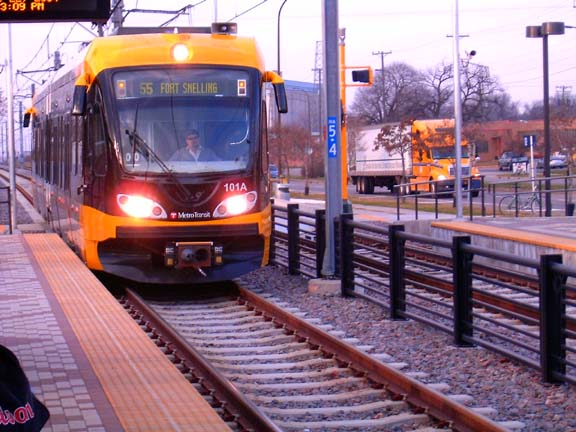 Minneapolis's Hiawatha LRT line has been repeatedly exceeding ridership targets a decade and a half early.
Success of the electric rail system has led to widespread community support for expansion, including a line connecting the city centers of Minneapolis and St. Paul.
Minneapolis's Hiawatha LRT line has been repeatedly exceeding ridership targets a decade and a half early.
Success of the electric rail system has led to widespread community support for expansion, including a line connecting the city centers of Minneapolis and St. Paul.
[Photo: Joe Kurland]
Missoula (Montana)
commuter rail
Myrtle Beach (SC)
Proposed light rail streetcar system
Nashville
Commuter rail expansion (see Nashville public transport developments)
New Orleans
35-mile streetcar system including the Desire streetcar line (see New Orleans public transport developments)
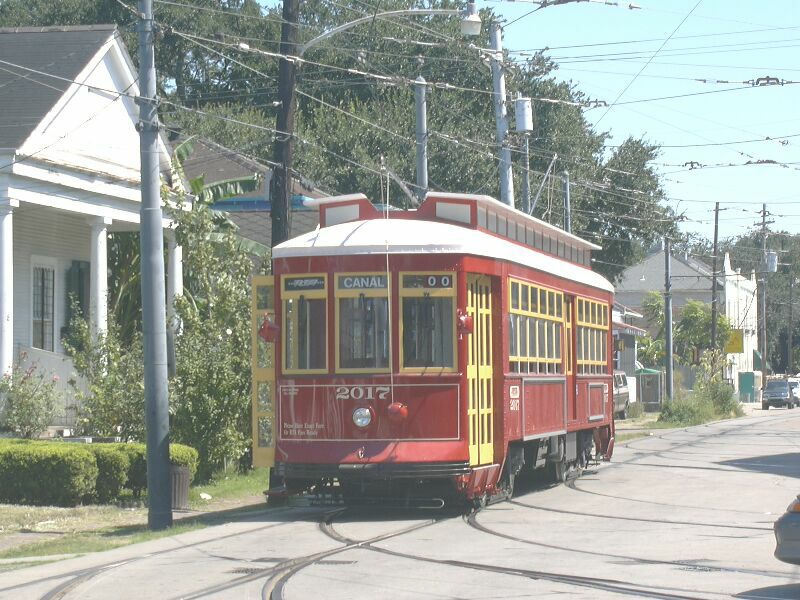 New Orleans built 31 new streetcars in-house for the Canal and Riverfront Streetcar Lines – modernized and improved versions of the
iconic and beloved Perley Thomas streetcars that are still operating in New Orleans after 84 years of service.
New Orleans built 31 new streetcars in-house for the Canal and Riverfront Streetcar Lines – modernized and improved versions of the
iconic and beloved Perley Thomas streetcars that are still operating in New Orleans after 84 years of service.
[Photo: L. Henry]
New York City
2nd Avenue Subway, 3rd Tunnel under Hudson, Penn Station to Grand Central
connection, 42nd St. light rail, Staten island light rail, commuter rail improvements (see New York City public transport developments)
Norfolk
Light rail plans in progress (see Norfolk public transport developments)
Ogden (Utah)
Streetcar plans
Omaha
Proposed light rail streetcar system
Orange County (California)
Centerline interurban light rail plan (previously voted down), streetcar system (see Orange County public transport developments)
Orlando
Light rail and commuter rail plans
Philadelphia
City Branch, Roosevelt Blvd. extension of Broad Street subway (see Philadelphia public transport developments)
Phoenix
90 miles of light rail already approved (see Phoenix public transport developments)
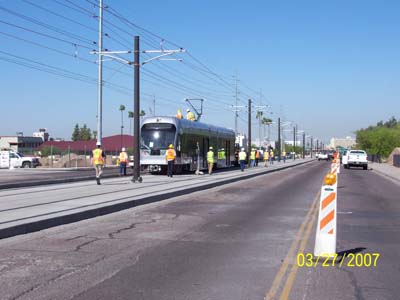 Construction of Phoenix's interurban electric light rail transit system is well under way.
Vehicle testing was already taking place in March 2007.
Construction of Phoenix's interurban electric light rail transit system is well under way.
Vehicle testing was already taking place in March 2007.
[Photo: Valley Metro]
Pittsburgh
Two light rail Lines north from current North Shore line under construction (see Pittsburgh public transport developments)
Portland OR
South Corridor light rail line, streetcar both sides of the river (see Portland public transport developments)
Providence
Proposed light rail streetcar system
Raleigh-Durham NC
Commuter rail and streetcar plans
Richmond
Light rail streetcar system proposed
Roanoke
Light rail streetcar system proposed
Rochester
Light rail (interurban or streetcar) system proposed, possibly using abandoned streetcar tunnel
Sacramento
Additional interurban light rail expansion, installation of streetcar system (see Sacramento public transport developments)
San Antonio
Streetcar light rail plan (previously voted down)
St. Louis
All plans evaluated, perhaps 100-mile interurban light rail system, streetcar system (see St. Louis public transport developments)
Salem (Oregon)
Streetcar plans
Salt Lake City
90 miles of light rail, streetcar, and commuter rail (see Salt Lake City public transport developments)
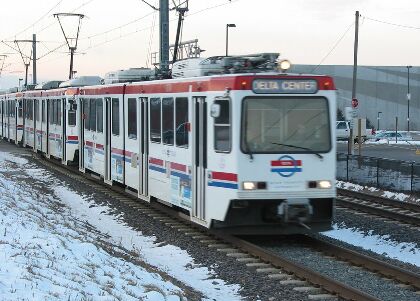 With one of the highest ridership growth rates in the USA, Salt Lake City's TRAX LRT system is widely considered a model of electric urban rail success.
Responding to the strong interest of surrounding communities – and overwhelming endorsement of LRT expansion by voters – the Utah Transportation Authority has
accelerated its urban and suburban rail transit development program.
With one of the highest ridership growth rates in the USA, Salt Lake City's TRAX LRT system is widely considered a model of electric urban rail success.
Responding to the strong interest of surrounding communities – and overwhelming endorsement of LRT expansion by voters – the Utah Transportation Authority has
accelerated its urban and suburban rail transit development program.
[Photo: © Frank Hicks]
San Diego
Light rail branch to north, another to west (see San Diego public transport developments)
San Francisco
New TransBay tunnel, trolley line, BART extension, eBART (light railway), Marin-Sonoma regional
passenger rail (or light regional railway), CalTrain extension to downtown TransBay Terminal (see San Francisco public transport developments)
San Jose
BART extension, several additional light rail extensions (see San Jose public transport developments)
Seattle
Proposed North and Eastside extensions (see Seattle public transport developments)
Spokane
Light rail inteurban-type or streetcar line planned (see Spokane public transport developments)
Tacoma
Plans for expansion of Tacoma Link streetcar and proposed heritage streetcar system (see Tacoma public transport developments)
Tampa
Light rail plans from 1992 and later; streetcar expansion (see Tampa public transport developments)
Toledo
Streetcar plans
Tucson
Streetcar project under way (see Tucson public transport developments)
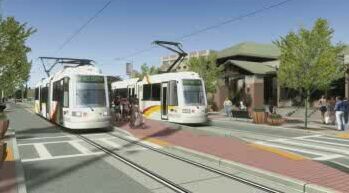 Tucson, Arizona is installing the first line of a modern electric light rail streetcar system.
This rendition shows two cars serving passengers at a typical station.
Tucson, Arizona is installing the first line of a modern electric light rail streetcar system.
This rendition shows two cars serving passengers at a typical station.
[Graphic: NC3D (Newlands & Company, Inc.)]
Visalia-Tulare (California)
Proposed interurban light railway or commuter rail
Washington (DC)
Tyson's Corner-Dulles extension, Purple Line, 40 miles of streetcar lines in DC, Columbia Pike light rail (see Washington public transport developments)
Winston-Salem
Light rail streetcar plans
Light Rail Now! website
URL: http://www.lightrailnow.org/features/f_lrt_2007-04a.htm
Updated 2007/05/08
More on Transportation Electrification
|
